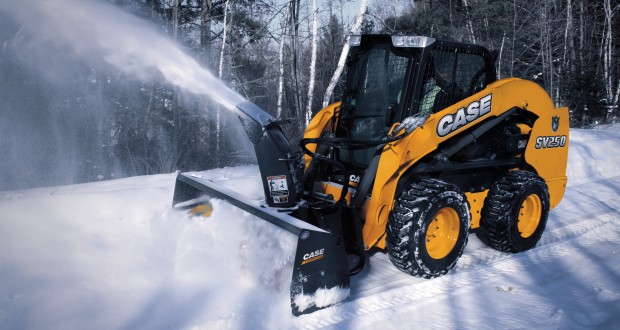A Primer in Skid-steer Hydraulics
By Warren Anderson

The auxiliary hydraulic capabilities of a skid-steer are one of the features that make it extremely versatile. Having a good understanding of the output you will need is important when you spec a machine. How much power is too much power, and how much power do your attachments need?
Attachments drive the decision
A skid-steer’s auxiliary hydraulic system provides the hydraulic flow that drives the machine’s attachments. The key to remember is that not all attachments have the same hydraulic flow requirement.
The most common system is the standard-flow auxiliary hydraulics package. Although flow rates differ by manufacturer and skid-steer model, the flow rate of a standard-flow system ranges from 17.5 to 24.2 gallons per minute (gpm)1. Standard-flow auxiliary hydraulics are included on all skid-steers from the factory and operate on the same pressure on which the machine’s main hydraulics operate, which is approximately 3,000 pounds per square inch (psi). A standard-flow system powers many of the most common hydraulic attachments on the market, such as 4-in-1 buckets, hydraulic hammers, augers, trenchers and grapples.
A high-flow auxiliary hydraulics system further increases a skid-steer’s versatility and productivity. As with standard-flow, it operates on the same pressures on which the main hydraulic circuits operate. The flow rate, however, ranges from 30.7 to 37.6 gpm. A high-flow system can be factory installed as an option or installed later in the field. It powers production-type attachments that require a high flow rate to perform as specified, like cold planers, rock saws, small mulchers and chipper/shredders.
When even more hydraulic power is required, an enhanced high-flow auxiliary hydraulics package is available. This high-performance option has flow rates that are similar to a skid-steer with a high-flow package, but operates up to 4,000 psi. Examples of attachments that require an enhanced high-flow system include larger cold planers, mulchers and rock saws.
Also available is a secondary auxiliary hydraulics system for applications that require multiple hydraulic movements simultaneously. This would include the side shift function on a cold planer or stump grinder, snow blower for direction change on the chute, or a tree spade with down riggers.
Understanding demands of attachments
A common misconception is that a standard-flow system can adequately run high-flow attachments. Powering high-flow attachments with a standard-flow skid-steer will lead to inefficient operation or damage the attachment/skid-steer.
When it comes to an enhanced high-flow auxiliary hydraulics package, it’s important to know the system is designed for extreme situations where the operators are truly pushing the limits. The enhanced high-flow package is only available on larger skid-steers with the horsepower available to ensure proper operation of the attachment.
Another common misconception and mistake in operation is that it’s best to run the attachment “wide open” and use all of the flow and pressure available. This is incorrect, and many attachments come labeled with optimal parameters for operation. Most large attachments are equipped with a pressure gauge to help operators run the attachment well within the recommended pressure guidelines for optimum cooling and performance. A good suggestion is to keep the attachment at 5 to 10 percent off of its maximum pressure to get optimum cooling and performance at the same time. Exceeding these ratings can lead to damage and unnecessary stresses on the machine.
Maintenance is universal
The maintenance involved in auxiliary hydraulic systems is essentially universal.
As with any hydraulically operated machine, it’s important to maintain the proper hydraulic fluid level as specified in the owner’s manual. The general guideline is to change hydraulic oil every 1,000 hours; filters should be changed every 500 hours. Always follow the recommendations in the owner’s manual.
Equally critical is the need to minimize the potential for contamination, whether it’s dirt, particulates or water. Check connection points to ensure they’re tight, and keep them clean. Contaminated hydraulic fluid decreases the life of the hydraulic pump and system, and can lead to more serious issues if not regularly changed out.
Viscosity is the single most important factor when selecting a hydraulic fluid to use in the skid-steer. Follow the manufacturer’s recommendations to select the viscosity grade to meet the machine’s operating requirements and climate in which the machine will be operating. Doing otherwise will result in poor performance or unnecessary damage. The wrong oil in a cold climate could lead to sluggish performance and damage to hydraulic components, while the wrong oil in a warmer climate may not provide the needed viscosity and may actually cause heat buildup in the unit.
With literally hundreds of attachments available and more introduced each year, it’s a given that the versatility of skid-steers will only continue to grow. By outfitting them with the right auxiliary hydraulic systems, skid-steer owners are able to capitalize on all the machines have to offer, achieve a favorable return on investment, and ultimately, add to the bottom line of their business in the process.
Warren Anderson is brand marketing manager at CASE Construction Equipment.
- CASE models used as reference.


